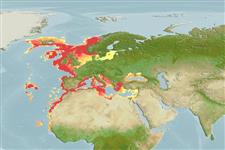Preferred temperature (Ref.
115969): 4.4 - 14.4, mean 8.7 (based on 480 cells).
Phylogenetic diversity index (Ref.
82804): PD
50 = 0.5000 [Uniqueness, from 0.5 = low to 2.0 = high].
Bayesian length-weight: a=0.00044 (0.00033 - 0.00057), b=3.27 (3.21 - 3.33), in cm Total Length, based on LWR estimates for this species (Ref.
93245).
Trophic level (Ref.
69278): 4.3 ±0.4 se; based on diet studies.
Resilience (Ref.
120179): Low, minimum population doubling time 4.5 - 14 years (K=0.06; tm=5-15 (female tm>10); Fec=3,000,000).
Prior r = 0.35, 95% CL = 0.23 - 0.53, Based on 7 data-limited stock assessments.
Fishing Vulnerability (Ref.
59153): Very high vulnerability (86 of 100).
Climate Vulnerability (Ref.
125649): Moderate vulnerability (38 of 100).
